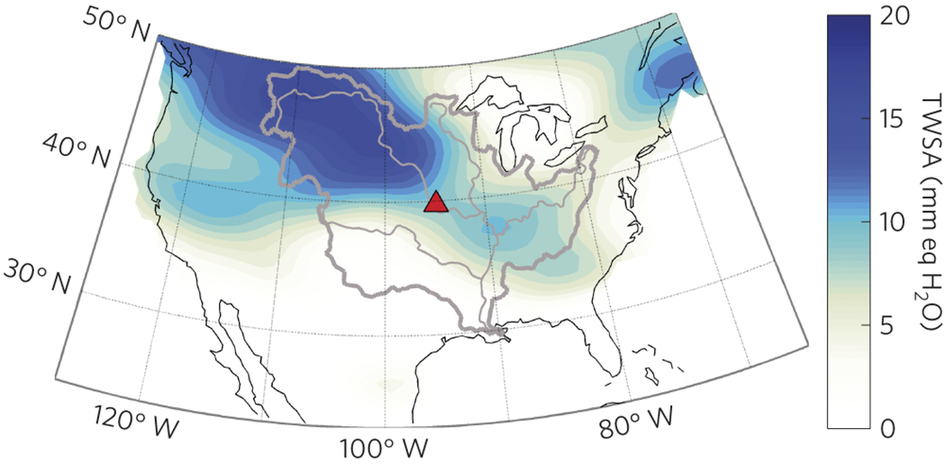Terrestrial water storage capacity and flood potential using GRACE
Inland flooding claims 133 lives and $4 billion in property losses in an average year in the U.S. Longer lead-time flood prediction could greatly minimize flood-related losses, but requires accurate information on the hydrologic state of an entire river basin, that is, its total water storage. Unfortunately, such comprehensive measurements are difficult to obtain with existing hydrological networks.
The GRACE satellite mission provides a means to observe monthly variations in total water storage within large (>200,000 km2) river basins based on measurements of changes in Earth’s gravity field: when the amount of water stored in a region increases, the gravity signal in that region increases proportionately, and is detected by the GRACE mission with tremendous accuracy. The terrestrial water storage signal defines the time-variable ability of the land to absorb and process water, and accounts for the water beneath the surface.
Soil moisture data is critical in the accurate prediction of floods and general runoff. One could argue that soil moisture primarily serves as a proxy in flood studies for the more critical water balance variable of storage, and for storage deficit [Beven and Kirkby, 1979]. GRACE data can show us when river basins have been filling with water over several months. When it finally rains and the basin is full, there is nowhere else for the water to go.
A remotely sensed, storage-based ‘flood potential’ method using GRACE observations has proven to be useful in identifying major flood occurrence globally [Reager and Famiglietti, 2009]. Over the GRACE record length, each region tends to exhibit an effective storage capacity, beyond which additional precipitation must be met by marked increases in runoff or evaporation. These saturation periods indicate the possible transition to a flood-prone situation.

The predictive ability of a GRACE-based flood potential has been compared to flood prediction models that use traditional input data sources such as river heights, snow amounts and the wetness of surface soils [Reager et al., 2014]. A case study of the catastrophic 2011 Missouri River floods showed that the inclusion of total water storage information has the potential to increase regional flood warning lead-times to as long as 5 months.
The method of GRACE storage deficit estimates could be used in combination with traditional methods of precipitation forecasting to help assess the likelihood for flooding. The periodic GRACE signal may also have value for global modeling, where grid-based models require some measure of effective storage capacity. Assimilation of the GRACE-based storage deficit could provide an additional benefit relative to current methods based on storage anomaly [Zaitchik et al., 2008].
References
Alsdorf, D. E., E. Rodriguez, and D. P. Lettenmaier (2007), Measuring surface water from space, Rev. Geophys., 45, RG2002, doi:10.1029/ 2006RG000197.
Beven, K. J., and M. J. Kirkby (1979), A physically based, variable con- tributing area model of basin hydrology, Hydrol. Sci. Bull., 24, 43–69.
Reager, J. T., and J. S. Famiglietti (2009), Global terrestrial water storage capacity and flood potential using GRACE, Geophys. Res. Lett., 36, L23402, doi:10.1029/2009GL040826.
Reager, J. T., Thomas, B. F., & Famiglietti, J. S. (2014). River basin flood potential inferred using GRACE gravity observations at several months lead time. Nature Geoscience, 7(8), 588-592.
Zaitchik, B. F., M. Rodell, and R. H. Reichle (2008), Assimilation of GRACE terrestrial water storage data into a land surface model: Results for the Mississippi River Basin, J. Hydrometeorol., 9, 535–548, doi:10.1175/2007JHM951.1.





